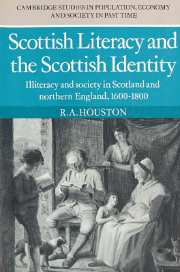 Scottish Literacy and the Scottish Identity
Scottish Literacy and the Scottish Identity Published online by Cambridge University Press: 11 November 2009
There were many occasions when the people of early modern Europe were called upon to authenticate a document with their personal subscription. Taxation documents, land or moveable property transfers (wills, dowry contracts or charters for instance), and the systematic questioning of military conscripts and prisoners during the nineteenth and twentieth centuries provide immediate examples. Let us look in detail at one of these sources in order to assess the usefulness of alternative sources to the court depositions used in the main body of our analysis. When we have assessed their value we will be in a better position to specify the type of source which will be most useful for comparing levels of literacy in Scotland and England in the early modern period.
As a source for the study of literacy, wills have been described as 'fundamentally unsatisfactory. Local studies, such as Spufford's Contrasting communities on rural Cambridgeshire, have shown that they present a distorted and exaggerated picture of illiteracy. Other writers have gratefully eschewed wills as a source in favour of the much more tractable, representative and reliable church court depositions. In some countries, however, wills and deeds are the only available documents which provide information on literacy attainment, and a variety of techniques have been used to compensate for their acknowledged biases. Lockridge has argued for colonial New England that the acknowledged biases in wills – age and debility increase illiteracy while greater wealth and status of testators diminish it – cancel out, leaving signatures on wills a fair facsimile of signatures among the population.
To save this book to your Kindle, first ensure [email protected] is added to your Approved Personal Document E-mail List under your Personal Document Settings on the Manage Your Content and Devices page of your Amazon account. Then enter the ‘name’ part of your Kindle email address below. Find out more about saving to your Kindle.
Note you can select to save to either the @free.kindle.com or @kindle.com variations. ‘@free.kindle.com’ emails are free but can only be saved to your device when it is connected to wi-fi. ‘@kindle.com’ emails can be delivered even when you are not connected to wi-fi, but note that service fees apply.
Find out more about the Kindle Personal Document Service.
To save content items to your account, please confirm that you agree to abide by our usage policies. If this is the first time you use this feature, you will be asked to authorise Cambridge Core to connect with your account. Find out more about saving content to Dropbox.
To save content items to your account, please confirm that you agree to abide by our usage policies. If this is the first time you use this feature, you will be asked to authorise Cambridge Core to connect with your account. Find out more about saving content to Google Drive.